Ajax-Farrell
Part Six
By Jose Cruz
and Peter Enfantino
Note: We rely on the fine people at Comic Book Plus and Digital Comic Museum for public domain digital downloads. Unfortunately, a full run of Fantastic Fears/Fantastic isn't available yet so we've had to resort to reading several stories via their reprints in the Eerie Publication titles, similarly available for download at this essential site. Though we'd obviously prefer to use the original comic books, we can't afford to purchase these very expensive issues. We thought this the best avenue rather than missing out on so many terror tales but, of course, it necessitates representing some artwork in black and white. We hope that you will agree with our decision and enjoy the stories in these altered formats. -Jose and Peter
Jose: There’s nothing like a horrible shipwreck to spice up your honeymoon. Pat and Lorna Fuller barely escape the wreckage of their cruise liner and use a safety raft to drift over to a deserted island. The signs look ominous: not only are there large, imposing sand dunes on the island, but the ground is riddled with strange claw marks too. It doesn’t take the couple long to discover their source. Pat races back from gathering firewood after hearing Lorna’s cries and sees a giant black ant trying to take a nibble out of his wife. Pat is able to beat the beast to a pulp, but any plans of escape are stymied by a troop of ants that have swarmed the beach. All the Fullers can do in defense is encircle themselves with a wide ring of fire to keep the monsters at bay. When the wood runs out and the flames die down, the Fullers take to beating the creatures off with sticks and running for the hills. In the scuffle Lorna is overtaken and hastily consumed by the ants. Maddened with grief, Pat lays waste to as many critters as he can before he too is defeated. Alas, even in death the lovers find peace, as their embracing skeletons testify.
Though it may be relatively low on the gruesome horror that has come to be typified with the pre-code comics, “Black Death” (from #4) earns brownie points for being a good old fashioned monster siege of the classic order. The threat of man-eating ants will be of particular nostalgic value to fans of radio drama, a medium which memorably adapted Carl Stephenson’s red-blooded saga “Leiningen versus the Ants” on several occasions. (The story also made it to the big screen as the Charlton Heston vehicle, The Naked Jungle.) “Black Death” takes a similar survivalist tact but there is a constant dark cloud of doom that hangs over our protagonists the entire way. The Fullers seem to have a sense that they’re licked from the start, running away for cover, their meager line of defense easily trumped by the patient insects. Their attempts at beating back the ants are wild and desperate, and though their failure is inevitable we still feel a tragic pang when Lorna is dragged away to the ants’ picnic. We sympathize with Pat’s final moments, determined to the bitter end to go down swinging. The final panel is grimly poignant, resonant with its message that some comforts can only be taken in death.
Peter: Two police officers, Pietro and Renzi, chase a criminal into the fetid sewers under the streets of Rome but somehow manage to lose him until a blood-chilling shriek alerts them. When, at last, they find the felon, he has been reduced to bones and shreds of flesh, eaten alive! Investigating further, the pair of frightened patrolmen uncover a gruesome treasure: an entire catacomb filled with human bones and a race of subhuman creatures. When the cops are cornered, Renzi tosses Pietro to the monsters and strikes a deal: he'll lead the ghouls to a smorgasbord of helpless victims if they'll rob banks for him. Millions in loot safely stashed away, Renzi keeps his side of the bargain by leading the flesh eaters to a camp for the homeless. The monsters gorge themselves on the poor and Renzi runs away, ashamed of his actions. When the cop doesn't show up for subsequent dinner invitations, the green ghouls come a'callin' at his place, kidnapping his wife and daughter and hightailing it back underground. By the time Renzi arrives to rescue his family, they've been picked clean. The monsters turn their attention to Renzi.
A decidedly unpleasant affair, "Fiends from the Crypt" (from the second issue, labeled #8) is one of those pre-code horror stories that make you appreciate why the code was born. Renzi may be a deviate and murderer, but his wife and daughter certainly didn't deserve the same fate as the Colonel's extra crispy drumsticks. Renzi's family become collateral damage as a result of his avarice and selfishness (the cop waves away any responsibility with a simple "This is a terrible thing I'm doing, but I must!"). The scene in the homeless shelter is particularly unsettling, with most of the events left to our imagination. It's a nasty, nasty little fable and I loved every panel!
Jose: Public commissioner Sam Green loves his work, but what he loves even more is the graft he receives from handing out construction contracts to the highest buyer. The public has seen one too many frivolous courthouses erected and not enough schools or homes for the citizens. An outcry is raised to have Green pay for his crimes. The fat cat and his toadie Maxie think they have this furor all figured out. After all, the judge on the case is getting a piece of the graft pie too! But justice is swift and Green is sentenced to 3-5 years in the clinker. This isn’t good news for Green: not only is his healthy allowance cut off, but he’s forced to stew inside a tight prison cell for hours and days on end, a punishment that is absolute torture for a man who needs breathing room in order not to feel “hemmed-in” all the time. Maxie arranges for his boss to get a cush job watching the cadavers get wheeled in and out of the prison morgue. Green’s new vocation allows him to come up with a brilliant escape plan. Biting down on his phobia, Green stows himself away in a coffin with the intent of being freed by Maxie upon his delivery to the city morgue. It all goes smoothly until Maxie arrives at the rendezvous and sees for himself just how frivolous the new city morgue really is. After all, where does one even begin to search in a facility fitted with over a thousand ice boxes to house its dead inhabitants…?
The just-desserts tale came to be identified with the suspense and horror titles over at Entertaining Comics, but on a few notable occasions the other pre-code publishers succeeded in “mimicking” the E. C. house style. “Caught in the Graft” (from #5) is one of these. With effective, sparsely-adorned artwork supplied by Harvey Comics stalwart Howard Nostrand, “Caught” remains a nice, clean-cut affair that hits all of the expected plot points without much fuss but a good deal of fun nonetheless. The narrative voice has a playful, sarcastic quality to it that is reminiscent of the way that E. C.’s stories would call out their villains (“Now the rest should be easy… what’s the matter, Maxie, something wrong?”) and a tone that matches the wiseguy attitude of the crooks and cheaters who populate the play. “Caught” may riff on old favorites, but the way it manages to offer up a new twist to the expected ending earns it further street cred in our book.
Peter: Living on a remote island, Lawrence Mason has only hatred for the millions of snakes that crawl across the landscape. He whiles away his oodles of free time by hunting out the serpents, shooting them, and dumping them in a huge pit. One night, while relaxing in front of a fire, Lawrence sees a beautiful woman peeking into his living room window. He brings her in to dry off by the fire and the girl introduces herself as Asptha. Mason quickly invites her to stay in his mansion and the gorgeous gal agrees. When Asptha retires for the evening, Lawrence finds a snake in the very chair she sat in! The next day, the new visitor comes out on the patio in time to witness Mason's morning ritual: shooting the snakes that have slithered into his garden. As they walk the island later that day, Asptha slips and falls into an underground cave and Mason climbs down to rescue her. What he discovers is a vast series of underground tunnels. At last finding his pretty house guest, Mason begs Asptha to follow him but the girl refuses, telling him this is where she belongs. Soon, the pair are surrounded by snakes and, as he lay dying, Lawrence Mason witnesses a terrifying transformation. Asptah is, in reality, the queen of the snakes!
I'll admit that the general plot line of issue #4's "Hissing Horror" (man who hates a species of animal so much that it comes back to bite him in the ass) has been done to death, and probably better in many cases, but there's something very charming about this particular variation. It may be the stark art or the goofy nuances (when Asptha reveals her true, slithery self, even her clothes transform into scales!). Why would a man who hates snakes so much retire to an island overrun with the things? Why does Mason dress up in a nice suit shirt and tie to go out in the garden and pick off the varmints? The daffy millionaire seems only sightly curious as to how this babe turned up on his island but then, once he got a look at her gams, I assume that the whole backstory became secondary to him.
Jose: This is the story of a coffin. Though the casket might be physically inert, the thinking mind that is part of its form is fully functional. It recounts its bloody beginnings as “a sturdy young oak” that provided shelter to Native American “savages” who proceeded to lay waste to a group of white settlers. From there the tree was cut down, along with its brothers, to be repurposed for later use. Still smarting from the severance, the tree takes vengeance on one of the lumberjacks by crushing him into a sappy pulp. Further tormented by the mutilations of a buzz saw, the tree is finally fashioned into a coffin fit for burial. Soon it is occupied with the body of one Mrs. Carson, a woman whom it is popularly believed was knocked off by her no-good husband. The coffin is ecstatic with the occupancy of the corpse, lovingly referring to the late missus as “it.” They have hardly been set into the ground when the coffin is dug back up and the corpse reexamined. When the body is found to carry traces of poison, the coffin is left empty and alone as Mr. Carson is punished for his crime. But the coffin needn’t worry, for soon it is joined with the cadaver of the executed Carson and placed back into the grave for all eternity to come.
Subtly perverse and wholly refreshing, “I, the Coffin” (from #7; reprinted Weird V. 1 #11) remains one of the more subversively imaginative yarns to come from the pre-code canon. Telling stories from the perspectives of traditionally non-living objects might not have been necessarily new to the medium—this story does actually pre-date the similar and more well-known “Tight Grip” from Tales from the Crypt #38—but the premise, when placed in the hands of a capable writer, always managed to bring a quirky and revelatory approach to familiar material. The talking coffin of this story is a particularly unique “anti-hero,” at turns droll and passionate in regards to life and death in a way that makes for oh-so-unsettling reading. There’s an almost sexual nature to the coffin’s longing for a body, a morbid coupling if there ever was one, that climaxes with the lovers snuggling under covers of graveyard earth. A cemetery workman’s winking jab about “reading so many of them horror stories” reassures us that this is only fiction, but it’s what occurs off the page behind closed doors (and under sealed lids) that will continue to resonate in the reader’s mind.
 |
| Shades of Poltergeist? |
From panel one, of the brittle Dawson laid up in a hospital bed, to its icky, Lovecraftian climax, "Stretching Things" (from #5) is The Ditko Show. A sneak preview of the delights to come half a decade later when Steve would become a mainstay of Atlas' science fiction titles, "Stretching Things" is an absolute uneasy delight. Borrowing elements from Quality's Plastic Man series and ripping off H.P.'s climax of "Cool Air," Ditko crafts an at-times funny, at-times genuinely scary fable of murder and greed. There's a moment when Dawson realizes he has no control over the holding of his own features that the reader almost becomes the character. What would you do if your face became silly putty and you couldn't get it back to its original shape? The final panel, what's left of Dawson's head melting into a pool of liquid flesh and blood, is one of the creepiest images of the pre-code era.
Without the hedging of the Code in effect, comic book writers of the 50s got the chance to tap into some dark territory that went beyond the superficialities of onstage gore. “Demon Fiddler” (from #7; reprinted in Weird V. 2 #4) is certainly not shy when it comes to the red stuff, but its power comes from a much more profoundly disturbing message that posits that all of mankind’s brutality is in actuality spurred on by the powers of Hell. One could argue the point that this in fact lessens the horror—not to mention the responsibility of our actions—but in its vision of a world being irrevocably driven to Armageddon by forces over which we have no control or hopes of bettering through understanding and mediation, “Demon Fiddler” achieves an all-consuming bleakness that only a few brave tales ever dared in the golden age of horror comics. It is a tale of anonymous terror; there is no one character here for us to sympathize with, so we are forced to simply witness this macabre parade as violence flashes from nearly every panel. Not even the “happy ending” of the fiddler getting his just desserts can do anything to brighten our moods. As the menacing, off-panel Master informs us, it’s simply a job that only needs one willing soul to start up again.
Peter: Two explorers stumble upon a dinosaur egg and take it back to America, where it's put on exhibit in a museum. When a night watchman turns the heat up in the gallery, the egg hatches and out pops a man-like dragon. The monster eats the guard and then escapes from the museum with an ancient yearning burning at its insides. Turns out the creature is a ghoul and desires carrion, so a local graveyard is first stop on its tour of this new world. Soon the police are alerted to the din's presence and a manhunt ensues. After tossing an innocent woman from a rooftop, the thing is chased into the swamp where the army finally blows it to kingdom come with tons of explosives. As the soldiers ponder the oddities of nature, the camera pans to the other side of the swamp and reveals an egg the creature laid before its obliteration.
I always appreciate the rare times the pre-code writers steeped out of the familiar "monster circle' and produced a tale revolving around something other than a vampire or werewolf. The lovable misfit of "Dragon Egg!" (from #7) is nothing more than a stranger in a strange land, unaccustomed to laws and good manners. We learn in a quick prologue that the monster was born of prehistoric times, but what exactly is it? One of the learned scientists who discover the "ovum" is quick to point out that the egg is too small to be that of a dinosaur but "it might be a brontosaurus!" and, I assume, his partner is too astonished by the find to question why a brontosaurus isn't a dinosaur. Extra points for the brute's ascent to the top of a ritzy apartment building to kidnap a gorgeous dame only to toss her off in a moment of pure, nasty pre-code sadism.
| The totally off-base splash panel is inadvertently brilliant for setting the reader up for a serious narrative blindsiding. |
In spite of a nonsensical title and an ending that takes away from its impact, “Be My Ghost” (from #8) is a powerfully wrought tale filled with hefty ideas and despair writ large. Most of its punch comes from the fact that the tale remains grounded in reality for its entire length; there is no relief to be found in the familiar form of a walking corpse or werewolf here. If “Demon Fiddler” showed a world at the mercy of unstoppable supernatural forces, “Be My Ghost” shows characters in the grip of unconquerable living conditions that force them to make decisions more damning than any satanic music possibly could. The story raises some uncomfortable questions about the “righteousness” of Pierre taking the lives of his fellow humans. He tries reasoning to himself that he is merely an “instrument of the state,” only a hand pulling a lever on a decision already made for him by a court of justice. The life of a woman, even a criminal, is sanctified to him though. (Perhaps in his mind he can’t help but picture Joan of Arc being brought to the pyre.) But in true O. Henry fashion, his determination to call it quits comes a second too late, as it always seems to in real life. The profound commitment of Pierre’s promise to Gigi is humbling, the result of a man legitimately trying to do the best by his family and being forced by circumstances both within and without himself to in effect destroy that same family. It’s a predicament more genuinely upsetting than the likes of many pre-code tales have presented to us, and even the tacked-on feel of the final panel does little to diminish the cold weight that presses down on our chests by the story’s end.
Peter: In 16th-century Scotland, Angus McCann and Mary McLeod must hide their love from their feuding families. One day, Mary's father and his men happen along and witness a secret meeting between the two young lovers; a skirmish ensues and Angus is stabbed to death. Later that night, in a vicious act of vengeance, Mary is shot with an arrow as she mourns in her castle room. Normally, that would be the end of the story but, this being a horror story, it's actually just the beginning. Some time passes and then, "one wild and stormy night," Angus McCann drags himself from his grave and hoofs it to Mary McCann's tomb. When he pries open the creaky coffin, he finds Mary waiting for him. The two decide to embark on a killing spree, wiping out the members of both their families. Mary will take care of Angus' kin and Angus will run through Mary's. The two soon make short work of the McCanns and McLeods and return to their respective resting places. But, even centuries later, you can still hear the two spirits arranging their next canoodle.
"If a Body Kill a Body" (from #9) has just about the most gleeful killing spree I've ever seen in a funny book. Angus and Mary set about their duties with a joy and verve that's almost contagious:
Angus: I'm sick for revenge, lass, on your people and mine as well! They destroyed us, shall we not destroy them?
Mary: Yes! We were young and in love and they killed all that! They must suffer also!
In that panel, the two characters are looking at the reader, as if to say, "Don't you agree?"
The script crackles with wit and sly twists (while murdering off the members of the clans one by one, the duo decide to expedite matters by initiating a meeting between the survivors of the two families, setting off a slaughter and the extinction of the McCanns and McLeods) and the art is well-done, the artist clearly enjoying the subject matter and giving it his all. The splash (far above) is about as subtly erotic as 1950s funny books got.
And the "Stinking Zombie Award" goes to...
Jose: Sailing a vessel dubbed the “Sea Monster” seems to be begging for trouble, yet that doesn’t stop its nameless “strange, old” captain from heading into the Sargasso Sea with hopes of hauling booty from all the sunken wrecks out there. One of his mates tries warning the codger about the vicious creature that’s reportedly caused all those wrecks, but the captain’s optimism (and madness) knows no bounds. Even foul weather does nothing to dampen his mood and he calls on the legendary beastie to do its worse. Happily obliging, the seaweed abomination calls the Cap out and the next thing the two are tussling under the waves, ending in the Cap’s death. The directionless crew attempt to first cook the Cap’s lucky pet albatross before hitting on the idea to send it out with an S. O. S. message. The bird lands on another ship and is promptly knifed to death. The second crew does get the message though and they head out to save their brothers. Alas, they’re too late; the “Sea Monster” is now a ghost ship and the actual sea monster attacks everyone on the rescuing vessel. “There’s no hope no hope for any of us! [sic]” wails a doomed soul.
| This is your brain on seaweed. |
Indeed. Pity the reader who is just as hopeful as the late captain that “Floating Coffin” (from #3) will improve as it goes along, because this stinker only takes on more and more water until all expectations are effectively sunk. Whether from an unskilled hand or just plain apathy, the tale suffers most prominently from an underdeveloped conflict and faceless, exchangeable characters. We don’t have any description or clue as to what the monster is before we see it literally laughing in the Captain’s face. “Of course it was living seaweed,” we seem to be told. “What else were you expecting it to be?” The sailors on the “Sea Monster” never feel genuinely imperiled, and it’s a wonder why the Kelp-Thing simply didn’t send the ship to its briny end to start with. Instead of focusing on the crew of the “Sea Monster” and the danger lurking right beneath them, the writer then decides to bring in an entirely new crew through the bizarre transitional effect of the messenger-bird only for them to suffer the same fate as the “Sea Monster” right when they come into the A-Plot. There’s a good story somewhere in here, but unfortunately for us it takes a detour into the Bermuda Triangle and leaves us with this forgettable piece of driftwood instead.
Peter: Native American Jimmy Bear enlists to fight Commies in the Korean War and fast becomes a celebrity, winning every race he enters at his camp. Jimmy makes fact friends with most of his comrades, but there are still some amongst the platoon who dislike Indians and make their racism known to Jimmy. When the men get trapped on a hillside and the ammunition goes low, Jimmy Bear volunteers to hoof it to the armoury to bring back supplies. The young GI faces insurmountable odds but he makes it back, only to be faced with racist slurs upon his arrival. Jimmy Bear knocks a few teeth out and teaches his comrades an important lesson in brotherhood.
Only one story in the run of Fantastic/Fantastic Fears jumped out at me as being especially noxious and that would be "Race for Valor" (from #4), a sleazy, racist piece of drivel masquerading as something else entirely. Oh, sure, there were weak vampire tales and an unending run of resurrected corpses that made me yawn but no other strip came close to sheer amateur hour than "Race." The uncredited writer may have felt he was making a bold statement about racism in the 1950s but the double standard he displays is almost laughable. How can one feel anger that Jimmy encounters ethnic slurs from a fellow GI when Bear himself is bellowing out "Dirty goonie buzzards" and addressing the enemy as "gooks?" The unattractive, sketchy art only added to the unwholesome feeling I got from this loser. And, with absolutely no horrific element whatsoever, this was a Fantastic Fear why?
NOTABLE QUOTABLES
| Lord of the Dance will return after these messages. |
“I t-think so! I’ve watched Uncle do it enough!”
- “And Death Makes Three”
"How I hate them both! If only I could do something to injure them! It would give me great pleasure!"
- "Haunted Matador"
“First time I ever had to arrest a flower!”
“I still think he’s nuts! Cassidy probably choked himself!”
- “The Blood Blossom”
Up from the fetid stench of Rome’s ancient catacombs swarmed the horrible army—strange and sinister beyond belief, sworn to destroy humanity in their terrible bone crunching jaws, slavering after the smell of human blood!
- “Fiends from the Crypt”
"Ers - Da - Estt - Gn - Bor - Ta!*
(He was a fool and a knave and was doomed from the start!")
-"Fiends from the Crypt"
And everywhere, as far as the eye could view, Roy saw bananas -- and more bananas -- yes, General Moreno had plenty of bananas.
- "Zombie's Bride"
Like a terrible steel beast, the car crunches and crunches down the steep, rock covered side of the mountain! There is a sound like doomed planets colliding…
- “Careless Corpse”
| Betty: Yeah, I'll get right on that. |
- “Careless Corpse”
Pelham Manor lay washed in the ghostly light of a half moon that was as sharp as the sickles used by the old Druids themselves!
- “Druid’s Castle”
"I'm scared to death, Chris. But I'll admit it's very thrilling!"
-"Druid's Castle"
When a man wants to live away from all others and have no contact with his fellow beings, something - is - wrong... the life he seeks is usually just death, hastening toward him, like a lover with open arms reaching out... these two know each other, the man and the death he chooses to call his own...
-"Hissing Horror"
"You go too far, ugly enemy! But you will join the legions of others lke you that I have slain! From the deepest corners of my heart I despise you... die! Die!"
-"Hissing Horror"
“You must have more cash somewhere!”
“Honest, mister, I haven’t! But here’s something worth more than money! It’s… the Devil’s Sketchbook!”
- “The Devil’s Sketchbook”
 |
| Kill the Drum Slowly |
- “Black Death”
Anne, upon purchasing a mummified human hand: “Just wait until I show it to the girls in the P. T. A. Club!”
- “Temple of the Beast”
“What do you think of it, Smith? A dinosaur egg?”
“No, too small! But it’s old! Very amazing find, sir! Might be a brontosaurus!”
- “Dragon Egg”
The Fiddler rules triumphant! Like a bloodthirsty vulture he roosts atop a smashed and bleeding world…
- “Demon Fiddler”
“Wow! Ain’t had so much fun since I used to beat up the little kids at home!”
- “Fear in the Jungle”
“Kaza knows not of what you speak, beautiful one! He also knows that if there must be a woman around, is good to have one who is good for eyes!”
- “Fear in the Jungle”
“We can live here, Mary, and none will bother us! The place is said to be haunted!”
“And so it is, now that we dwell here!”
- “If a Body Kill a Body”
“Mary! Did you do as well as I? I threw your mother from the ramparts!”
“Hee-hee! And I poisoned your father! He died terribly!”
- “If a Body Kill a Body”
“There was no escape from the horrible revenge of the man who wouldn’t stay murdered…”
- “Crack-Up”
“A very strange case indeed—I’d call it hyper-induced vampirism!”
- “Scream No More, My Lady”
 |
| Rude! |
"Oh, yes! Ho-ho-ho-ho-ho! And now, my dear..."
"Eeeeeekkk- Ohhhhh- Ahhhhhh-"
-"Scream No More, My Lady"
“Ugh—the very air has turned cold and she seems to waft an aroma that smacks of a tomb…”
- “The Tiger’s Paw”
“It took all of my strength to pull her away, but you must remember, this was not a woman, it was a full fledged tigress!”
- “The Tiger’s Paw”
Tommy Malloy was a fast man - with a dollar, a dame, or a racing car! But he never dreamed that someday he would drive that car of his right over the edge of reality and into the realm of dark doom from whence no man ever returns! For a man cannot live when a part of him is lost, even though the lost part is dead and long buried! This, then, is the weird and incredible story of the arm that came back...
-"Doom at the Wheel"
STORY OF THE MONTH
Jose: Insanity cannot be calculated or created with intent. It is an entirely accidental process. This is why some stories that have a certain level of insanity (or inanity) fall flat on their face, like “Floating Coffin,” while others seem to work in narrative derangement the way a painter might work in oils, as in the case of our third “coffin” story for this month, “Secret Coffin” (from #9). “Secret Coffin” suffers from a severe case of schizophrenia with a healthy dose of ADD tossed in for good measure. It simply cannot decide what it wants to focus on: first we see ghosts with no identity or backstory provided, then we’re introduced to an enterprising heir who wants to turn the family castle into a wax museum, then it focuses on him using murder to provide his exhibits, then the random ghosts reappear to deliver what we assume are just desserts before the whole shebang goes up in smoke. Repeating information, zipping through character development and action at breakneck pace, and feeling like a chunk of important panels have been left on the cutting room floor, “Secret Coffin” will leave your mind in the same shape as the haunted castle at its center: blown to pieces.
Peter: My compadre Jose makes a wonderful and entirely accurate observation about insanity in regards to pre-code horror funny books. My story of the month is the most insane color strip I've ever read. "Green Horror" has been one of my favorite dollops of 1950s goofiness since I read it in a reprint mag called Extinct! 25 years ago and provides one of the best examples of why we comic-nuts dig this stuff. So much to digest; so much to question. Why does George Thorton have such an irrational hatred for a random cactus? Because his wife is smitten with the thing? What kind of woman remarries mere months after the love of her life is found with an axe in the back of his skull? Why is the big green guy such a thorny subject for Hubby #2 as well? Why does our titular character expire after "spending his loose change" with the human object of his lust? I don't know. All I know is that "Green Horror" presents that perfect storm of great art (how about the Munch cameo on page 3, panel 3, and that great leer from Mr. Green in the climax?) and a solid...ly wacky script.
***
The Ten Best Ajax-Farrell Horror Stories
Jose
- "Corpses... Coast to Coast" (Voodoo #14)
- "Fog Was My Shroud" (Voodoo #16)
- "Demon Fiddler" (Fantastic #7)
- "Out of the Grave" (Haunted Thrills #11)
- "Be My Ghost" (Fantastic #8)
- "I, the Coffin" (Fantastic #7)
- "Fatal Scalpel" (Haunted Thrills #5)
- "Trumpet of Doom" (Haunted Thrills #14)
- "Nightmare Merchant" (Strange Fantasy #7)
- "Cry from the Coffin" (Strange Fantasy #8)
Peter
1. "Screams in the Night" (Haunted Thrills #7)
2. "Experiment in Terror" (Haunted Thrills #13)
3. "Corpses of the Jury" (Voodoo #5)
4. "Green Horror" (Fantastic Fears #8)
5. "Hands of Terror" (Haunted Thrills #5)
6. "Bloody Mary" (Strange Fantasy #10)
7. "Out of the Grave" (Haunted Thrills #11)
8. "Plantation of Fear" (Voodoo #3)
9. "Skulls of Doom" (Voodoo #12)
10. "Torture Garden (Voodoo #13)
The Comics
Fantastic Fears #7, 8, 3-9
Fantastic #10, 11
![]() #7 (1) (May 1953)
#7 (1) (May 1953)
Cover by Robert Webb
“And Death Makes Three”
Art Uncredited
“Curse or Coincidence” **MISSING**
Art Uncredited
“Hawk’s Folly”
Art Uncredited
“The Blood Blossom”
Art Uncredited
![]()
#8 (2) (July 1953)
Cover by Robert Webb
“Fiends from the Crypt”
Art Uncredited
“Little Red Riding Hood and the Big Bad Werewolf”
Art by Myron Fass
“Careless Corpse”
Art by Joe Doolin
“Carnival of Terror”
Art Uncredited
![]() #3 (September 1953)
#3 (September 1953)
Cover Uncredited
“Haunted Matador”
Art Uncredited
“The Zombi’s Bride”
Art Uncredited
“Druid’s Castle”
Art Uncredited
“Floating Coffin”
Art Uncredited
![]()
#4 (November 1953)
Cover Uncredited
“Hissing Horror”
Art Uncredited
“Race for Valor”
Art Uncredited
“Devil’s Sketch Book”
Art Uncredited
“Black Death”
Art Uncredited
![]() #5 (January 1954)
#5 (January 1954)
Cover Uncredited
“My Coffin Must Wait”
Art Uncredited
“Caught in the Graft”
Art by Howard Nostrand
“Stretching Things”
Art by Steve Ditko
“Escape from Hell”
Art by Jack Abel
“Temple of the Beast”
Art Uncredited
![]() #6 (March/April 1954)
#6 (March/April 1954)
Cover Uncredited
“Hollow Horror” **MISSING**
Art by Robert Webb
“Eyes of Terror” **MISSING**
Art Uncredited
“Tonight I Die” **MISSING**
Art Uncredited
“Your Coffin is Waiting, Sir!”
Art Uncredited
![]() #7 (May/June 1954)
#7 (May/June 1954)
Cover by Robert Webb
“Dragon Egg”
Art Uncredited
“Inhuman Killer” **MISSING**
Art Uncredited
“I, the Coffin”
Art by Robert Webb
“Demon Fiddler”
Art Uncredited
![]() #8 (July/August 1954)
#8 (July/August 1954)
Cover by Robert Webb
“Terror Under Glass”
Art by Robert Webb
“Fear in the Jungle”
Art Uncredited
“Be My Ghost”
Art Uncredited
“Green Horror”
Art by Ken Battefield
![]() #9 (September/October 1954)
#9 (September/October 1954)
Cover Uncredited
“If a Body Kill a Body”
Art Uncredited
“Deadly Wish”
Art Uncredited
“Secret Coffin”
Art by Carl Burgos
“Broom for a Witch”
Art Uncredited
![]() #10 (November/December 1954)
#10 (November/December 1954)
Cover Uncredited
“Doom at the Wheel”
Art by Robert Webb
“Crack-Up”
Art Uncredited
“Scream No More, My Lady”
Art Uncredited
“Fate Laughs at Clowns”
Art Uncredited
![]() #11 (January/February 1955)
#11 (January/February 1955)
Cover Uncredited
“The Tiger’s Paw”
Art Uncredited
“Dangerous Voyage”
Art Uncredited
“Bewitched Battalion”
Art Uncredited
“Gravestone for Gratis”
Art by Lee Williams
1. "Screams in the Night" (Haunted Thrills #7)
2. "Experiment in Terror" (Haunted Thrills #13)
3. "Corpses of the Jury" (Voodoo #5)
4. "Green Horror" (Fantastic Fears #8)
5. "Hands of Terror" (Haunted Thrills #5)
6. "Bloody Mary" (Strange Fantasy #10)
7. "Out of the Grave" (Haunted Thrills #11)
8. "Plantation of Fear" (Voodoo #3)
9. "Skulls of Doom" (Voodoo #12)
10. "Torture Garden (Voodoo #13)
Fantastic Fears #7, 8, 3-9
Fantastic #10, 11
 #7 (1) (May 1953)
#7 (1) (May 1953)Cover by Robert Webb
“And Death Makes Three”
Art Uncredited
“Curse or Coincidence” **MISSING**
Art Uncredited
“Hawk’s Folly”
Art Uncredited
“The Blood Blossom”
Art Uncredited

#8 (2) (July 1953)
Cover by Robert Webb
“Fiends from the Crypt”
Art Uncredited
“Little Red Riding Hood and the Big Bad Werewolf”
Art by Myron Fass
“Careless Corpse”
Art by Joe Doolin
“Carnival of Terror”
Art Uncredited
 #3 (September 1953)
#3 (September 1953)Cover Uncredited
“Haunted Matador”
Art Uncredited
“The Zombi’s Bride”
Art Uncredited
“Druid’s Castle”
Art Uncredited
“Floating Coffin”
Art Uncredited
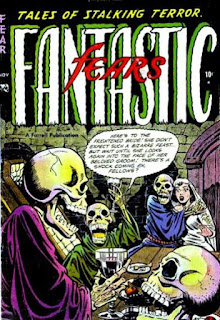
#4 (November 1953)
Cover Uncredited
“Hissing Horror”
Art Uncredited
“Race for Valor”
Art Uncredited
“Devil’s Sketch Book”
Art Uncredited
“Black Death”
Art Uncredited
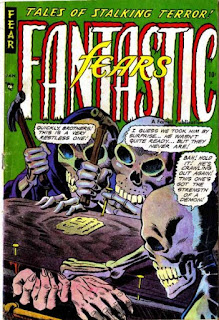 #5 (January 1954)
#5 (January 1954)Cover Uncredited
“My Coffin Must Wait”
Art Uncredited
“Caught in the Graft”
Art by Howard Nostrand
“Stretching Things”
Art by Steve Ditko
“Escape from Hell”
Art by Jack Abel
“Temple of the Beast”
Art Uncredited
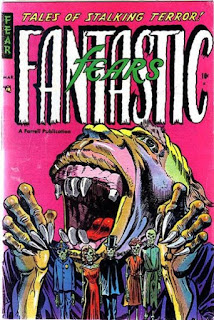 #6 (March/April 1954)
#6 (March/April 1954)Cover Uncredited
“Hollow Horror” **MISSING**
Art by Robert Webb
“Eyes of Terror” **MISSING**
Art Uncredited
“Tonight I Die” **MISSING**
Art Uncredited
“Your Coffin is Waiting, Sir!”
Art Uncredited
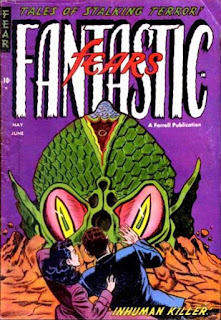 #7 (May/June 1954)
#7 (May/June 1954)Cover by Robert Webb
“Dragon Egg”
Art Uncredited
“Inhuman Killer” **MISSING**
Art Uncredited
“I, the Coffin”
Art by Robert Webb
“Demon Fiddler”
Art Uncredited
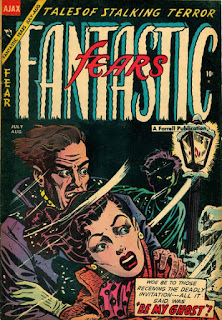 #8 (July/August 1954)
#8 (July/August 1954)Cover by Robert Webb
“Terror Under Glass”
Art by Robert Webb
“Fear in the Jungle”
Art Uncredited
“Be My Ghost”
Art Uncredited
“Green Horror”
Art by Ken Battefield
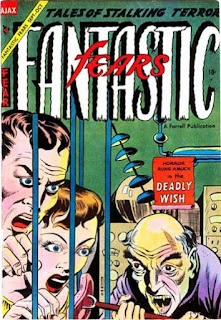 #9 (September/October 1954)
#9 (September/October 1954)Cover Uncredited
“If a Body Kill a Body”
Art Uncredited
“Deadly Wish”
Art Uncredited
“Secret Coffin”
Art by Carl Burgos
“Broom for a Witch”
Art Uncredited
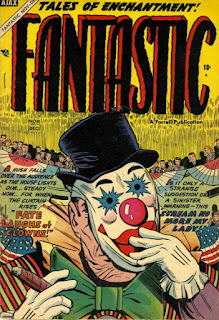 #10 (November/December 1954)
#10 (November/December 1954)Cover Uncredited
“Doom at the Wheel”
Art by Robert Webb
“Crack-Up”
Art Uncredited
“Scream No More, My Lady”
Art Uncredited
“Fate Laughs at Clowns”
Art Uncredited
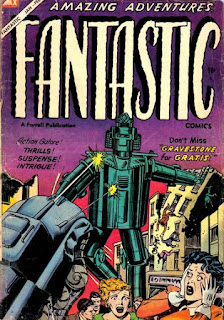 #11 (January/February 1955)
#11 (January/February 1955)Cover Uncredited
“The Tiger’s Paw”
Art Uncredited
“Dangerous Voyage”
Art Uncredited
“Bewitched Battalion”
Art Uncredited
“Gravestone for Gratis”
Art by Lee Williams
***
SPECIAL NOTE: This entry marks the final post in our "Dungeons of Doom" series appearing on this blog. From this point forward, "Dungeons of Doom" will continue in the form of its very own print zine. Each volume will focus on a single publisher and cover the entire breadth of the pre-code horrors. The first two volumes will reprint our work here on the Harvey and Ajax-Farrell titles, and in addition to the content seen on this site there will be all-new material included in the print edition for your reading pleasure. Further details will be divulged in the future as we go into production, so be sure to watch this space for the premiere of the most comprehensive study of the best horror tales from the silver age of comics!
But in the meantime...
BEWARE!
Come March 7th, the bare•bones staff will begin their month-by-month foray into the world of...
E. C. COMICS!




































































































































































































































































